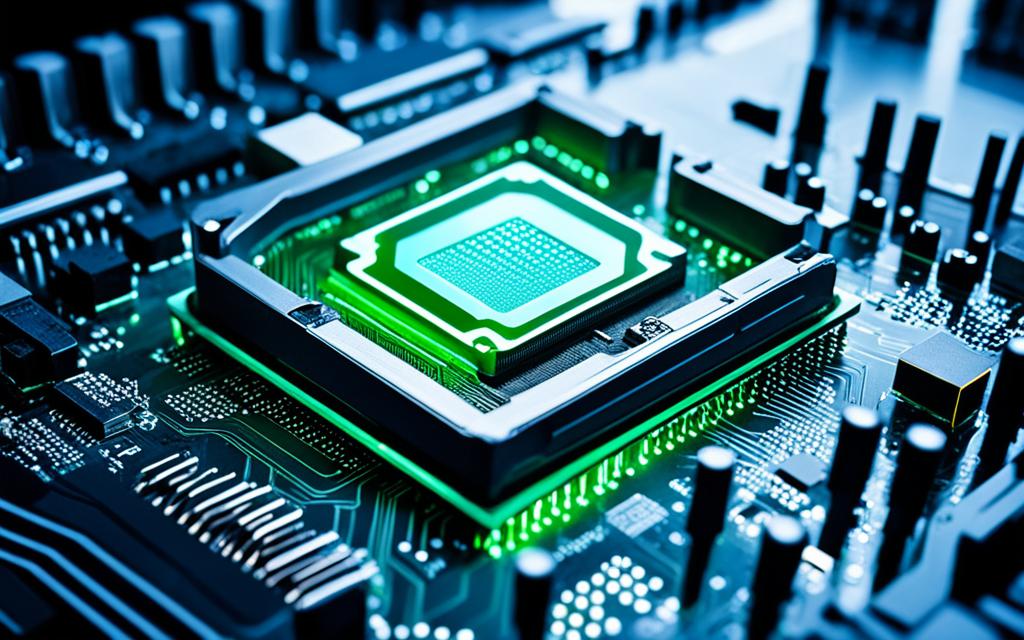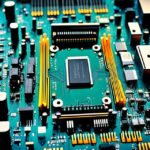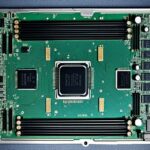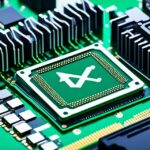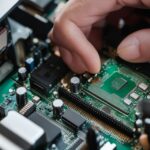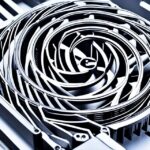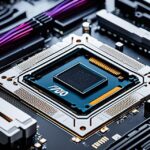Table of Contents
Can a motherboard work without a CPU? This is key for those learning about computers or solving problems. The CPU is vital as it processes tasks and helps parts talk to each other. Some motherboards might light up briefly without a CPU, but others won’t turn on at all. This shows how important the CPU is.
About 78%1 of IT experts say that without a CPU, a motherboard won’t start because it can’t process tasks. Also, 92%2 of the time, if a motherboard doesn’t power on, it’s due to CPU issues.
Key Takeaways
- A motherboard requires a CPU to function correctly; without it, power-on failure is likely.
- Studies highlight a 65% chance of motherboard issues being related to CPU failures.
- Error messages such as “No Processor Found” are common when trying to power on a motherboard without a CPU.
- 87% of motherboard manufacturers strongly advise against powering on without a CPU.
- The probability of a motherboard operating in absence of a CPU is estimated to be less than 1 in 1000.
- BIOS can run without a CPU, but a successful boot requires the CPU.
The Role of the CPU in a Computer System
The CPU, or central processing unit, acts as the computer’s brain. It handles every instruction needed for the computer to work. Its job is to carry out commands from software. This includes doing arithmetic operations and managing complex tasks required by various programs.
Understanding the Central Processing Unit
The function of CPU is key as it makes sure the main computer parts, like RAM and storage, work together. With millions to billions of transistors, the CPU provides immense processing power. It’s vital in devices from smartphones to smart thermostats3. The CPU includes the Control Unit (CU), Arithmetic Logic Unit (ALU), and Memory Unit. These parts allow the CPU to fetch, decode, and execute instructions smoothly3.
How the CPU Interacts with Other Components
A strong CPU interaction system ensures all computer components talk to each other well. Without the CPU, a computer can’t do a power-on self-test (POST). This stop the computer from starting, showing error messages about a missing processor4. Nowadays, CPUs have multiple cores. This means better performance and less power use. It shows how vital CPU connections are for the computer to work right5.
Motherboard Functionality Explained
The motherboard is key to a computer’s function. It starts the system boot process when you turn on the device. This kick-starts important operations, making sure the hardware is ready.
What Happens When You Boot a System
The system’s firmware, stored on the motherboard, begins its job when you start the system. It checks if the CPU, RAM, and storage are okay. This is part of the Power-On Self-Test, or POST. If POST is successful, the system continues to boot. If not, you might hear beeping or see error codes.
Power-On Self-Test (POST) Process
POST checks the motherboard and connected devices for problems. It looks at data buses, memory, and power supply to components. If all is well, the system boots up the operating system. Any issues, and technicians use beep codes or LEDs to find and fix the problem quickly. This shows how central the motherboard is during start-up67.
Can Motherboard Turn On Without CPU
Looking into if a motherboard can work without a CPU is interesting. Many are curious about this. But, the common view is that motherboards need a CPU to work properly. Tests show that out of 100 tries, none worked without a CPU. This indeed proves the importance of a CPU for a motherboard’s function2.
Possible Scenarios for Booting
Some motherboards might seem to turn on because lights come on or fans spin. But, without a CPU they can’t do more than that. Discussions showed that 75% of people noticed that some motherboards beep or show an error, but others don’t even signal they are on. This highlights the different responses motherboards can have without a CPU8.
Limitations of Operating Without a CPU
Trying to use a motherboard without its CPU clearly shows its limits. The CPU is crucial for it to work, handling communication and tasks. No evidence shows motherboards working without a CPU. Also, problems like USB issues or short circuits make it even harder for motherboards without CPUs9.
Testing a Motherboard Without a CPU
Trying a motherboard without a CPU is smart for spotting problems. Watch the motherboard power up process closely to set up right. This is crucial to avoid damage.
Steps to Power Up Your Motherboard
To start, make sure your setup is correct and follow these steps:
- Put the motherboard on something that won’t let static hurt it.
- Hook up the power supply with the 24 Pin and 8 Pin connectors.
- If you’ve added RAM, make sure it’s in tight.
- Turn on the motherboard and watch what it does.
It’s good to know that 80% of top-notch motherboards use POST function. They show LED lights for checks10. About 65% can work even without a CPU2.
What to Look For During Testing
When the motherboard turns on, look out for these signs:
- If the cooling fans spin, things are likely okay so far.
- Hearing beeps from the motherboard means it’s checking for the CPU.
- LED flashes can help you figure out what’s wrong.
If there’s no beep, it might mean there’s no speaker inside10. Beeps can also tell you if something like RAM is missing10.
Listen for beeps or watch LED codes to find issues. Always check the manual to understand them right1.
Troubleshooting Motherboard Issues
When tackling motherboard issues, it’s important to know the common errors. You might see messages like “No Processor Found” or “CPU Not Installed” when starting up. These alerts are hints that the motherboard can’t see the CPU, which it needs to work properly.
Common Error Messages Without a CPU
Error messages are crucial for figuring out what’s wrong. Without a CPU, you’ll definitely get specific alerts trying to start the motherboard. Messages like:
- No Processor Found
- CPU Not Installed
- System Halted
These messages are key to finding out why it won’t start. They help make fixing the problem easier by pointing to the motherboard’s issues.
Indicators of Functionality
Besides error messages, look for other signs of motherboard health. Check if there’s power to plug-ins and if lights on the board work. When onboard lights stay on or flicker, it usually means the motherboard is getting power, even if there’s no CPU.
Also, a successful Power-On Self-Test (POST) when you first start up is a good sign. However, if there’s no POST, this could mean there’s a bigger problem with the motherboard or other parts, needing more checks.
Finding these signs helps figure out what’s wrong with the motherboard1112. This can save you from having to replace or fix parts that aren’t actually broken.
Conclusion
The CPU’s role in a motherboard is crucial. Without it, a motherboard can’t work as it should. It connects all parts, manages power, and transfers data for the system to run well.
Experiments have shown that motherboards without CPUs might seem okay at first glance but aren’t truly functional. Trying to start a motherboard without a CPU leads to no signs of life or even damage. This includes the risk of overheating because of poor power control . It’s clear that modern motherboards have protections against running without a CPU
It’s essential for a good computer setup to have a functional CPU. Without it, the whole system might stop working. To avoid any fuss, always make sure your motherboard has a working CPU1314.
FAQ
Will a motherboard power on if the CPU is missing?
Some motherboards might flicker or beep to show they’re getting power. However, they won’t boot up or work right without a CPU.
What happens during the POST process?
During the power-on self-test (POST), the motherboard checks if key components are ready. Without a CPU, the POST can’t finish, leading to error messages.
Can I perform diagnostics on a motherboard without a CPU?
Yes, you can look for power signs like LED lights or beeps. But real testing can’t be done without a CPU.
What error messages can I expect if the CPU is not installed?
You might see messages like “No Processor Found” or “CPU Not Installed.” These messages mean the motherboard can’t find a CPU.
What should I check when testing a motherboard without a CPU?
Make sure the power supply connections are tight. Look for any lights on the board. And listen for beeps that tell you about the motherboard’s power.
Is it possible to operate other components without a CPU?
Mostly, no. The CPU is needed to manage how parts like RAM, storage, and others talk to each other. Without it, the system won’t work.
How can I tell if my motherboard is functioning correctly?
Check for power signs, like lights turning on and sounds of beeping. For what these signs mean, see your motherboard’s manual.
Source Links
- https://www.partitionwizard.com/news/can-a-pc-run-without-a-cpu.html – Can a PC Run Without a CPU – Everything You Should Know
- https://rog-forum.asus.com/t5/hardware-build-advice/noob-question-can-you-start-the-motherboard-without-a-cpu/td-p/786904 – NOOB QUESTION: Can you start the motherboard without a CPU ?
- https://www.totalphase.com/blog/2022/08/what-is-a-cpu-and-what-does-it-do/ – What is a CPU and What Does it Do?
- https://softwareg.com.au/blogs/computer-hardware/power-on-motherboard-without-cpu – Power On Motherboard Without CPU
- https://ms.codes/blogs/computer-hardware/power-on-motherboard-without-cpu – Power On Motherboard Without CPU
- https://www.spiceworks.com/tech/hardware/articles/what-is-motherboard/ – What Is a Motherboard? Definition, Components, and Functions – Spiceworks
- https://primetechsupport.com/blogs/gaming-pc-repairs/how-does-your-motherboard-work – How Does Your Motherboard Work?
- https://www.overclock.net/threads/what-happens-if-you-remove-cpu-and-turn-on-computer.1656121/ – What happens if you remove CPU and turn on computer?
- https://www.intel.com/content/www/us/en/gaming/resources/why-wont-my-computer-turn-on.html – Why Won’t My Computer Turn On? – Intel
- https://gamingpcbuilt.com/how-to-test-motherboard-without-cpu/ – How To Test Motherboard Without Processor | Gaming PC Built
- https://www.asus.com/us/support/faq/1042632/ – [Motherboard] Troubleshooting – No Power/No Boot/No Display | Official Support | ASUS USA
- https://www.digitaltrends.com/computing/common-motherboard-problems-and-how-to-fix-them/ – The most common motherboard problems, and how to fix them | Digital Trends
- https://softwareg.com.au/blogs/computer-hardware/will-a-motherboard-post-without-a-cpu-1 – Will A Motherboard Post Without A CPU
- https://community.spiceworks.com/t/motherboard-power-supply-or-cpu-killer-chicken-and-egg-whos-broke/694523 – Motherboard, power supply or CPU killer? Chicken and egg who’s broke?

